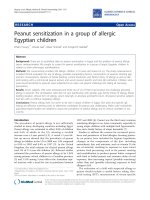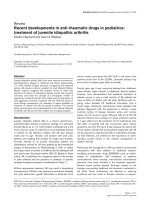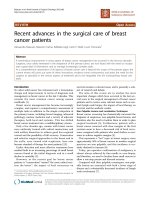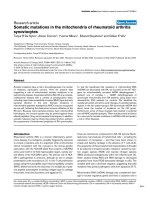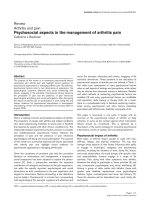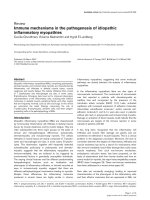Báo cáo y học: "Recent advances in nanoparticle formulation of oleanolic acid" docx
Bạn đang xem bản rút gọn của tài liệu. Xem và tải ngay bản đầy đủ của tài liệu tại đây (240.41 KB, 4 trang )
REVIE W Open Access
Recent advances in nanoparticle formulation of
oleanolic acid
Meiwan Chen
†
, Zhangfeng Zhong
†
, Wen Tan, Shengpeng Wang and Yitao Wang
*
Abstract
Oleanolic acid (OA) is a natural triterpenoid possessing anti-inflammatory, antitumor, antiviral, hepatoprotective and
antihyperlipidemic effects. Research on the pharmacological activities and clinical applications of OA has made
significant progress in the past decade, particularly in the areas such as isolation and purification, chemical
modifications, pharmacological research, toxicity studies and clinical use of OA. However, due to its poor aqueous
solubility, instability and low bioavailability, OA’s clinical applications are still rather limited. Recently,
nanoparticulate drug delivery as the biological dimension of nanotechnology has been developed, which may help
generate useful formulations of OA for clinical applications. Nanoparticulate drug delivery system enhances the
dissolution rate and bioavailability of OA, providing a feasible formulation method for clinical applications.
Introduction
Oleanolic acid (OA), a naturally occurring pentacyclic tri-
terpenoid extracted from the l eaves and roots of Olea
europaea, Viscum album L., Aralia chinensis L. and over
120 other plant species [1], is chemically known as 3b-
hydroxy-olea-12-en-28-oic acid [2] (Figure 1). OA exhi-
bits many biologic al activities such as anti-inflammatory,
antitumor, antiviral, hepat oprotective and anti-hyperlipi-
demic effects. OA has been used in Chinese medicine to
treat liver disorders for over 20 years [2]. Conventional
formulations of OA are tablets and capsules [3]; however,
OA’s poor aqueous solubility and low bioavailability in
vivo ma ke it necessary to dev elop new formulations for
clinical applications.
Derived from nanotechnology, nanoparticulate delivery
system provides an innovative approach to drug delivery
[4-7]; nanoparticulate technique reduces particles to
nanometer ranges, thus reducing t he dose and reactive
nature of the molecule [8]. Various nanoparticulate drug
delivery systems have been explored, such as nanoparti-
cles, nanospheres, nanocapsules, solid lipid nanoparticles
(SLN), self-emulsifying drug delivery systems (SEDDS)
and submicron/nanoemulsions [9][10]. Compared to
conventional dosage forms, nanoparticulate drug deliv-
ery system has many advantages, namely enhancement
of solubility and stability, pro tection from toxicity,
enrichment of pharmacological activities, improvement
of tissue macrophage distribution, bioavailability and
sustained delivery, protection from physical and chemi-
cal degradation [7,11].
This article reviews recent advances in nanoparticulate
formulation of OA.
Solid lipid nanoparticles
Solid lipid nanoparticles (SLN), which remain solid at
room temperature, have emerged as a new pharmaceuti-
cal delivery system or formulation to modify the release
profile for many drugs [12]. SLN has characteristics of
drug carriers such as lipophilicity, hydrophilicity as well
as low bio-toxicity. Main advantages of SLN include:
controlling drug release, targeting with reduced toxicity,
increasing drug stability and high drug payload [13].
High pressure homogenization is an established
method for SLN production. Film-ultrasound dispersion
technique is another rational and practicable method for
developing a new OA injection [9]. A study showed that
the OA solid lipid nanoparticles (OA-SLN) by film-
ultrasound dispersion technique were with the diameter
(62.0 ± 10.3) (mean ± standard devi ation) nm, encap su-
lation efficiency (98.29%), loading rate (8.17%) in OA-
SLN [9]. In another study, the researchers prepared OA
solid lipid nanoparticles using the optimal preparation
conditions (ultrasonic wave time 40 min, OA-phospholi-
pids (1:8), 60 g/L mannitol 15 mL) by film-ultrasonic
* Correspondence:
† Contributed equally
State Key Laboratory of Quality Research in Chinese Medicine, Institute of
Chinese Medical Sciences, University of Macau, Macao SAR, China
Chen et al. Chinese Medicine 2011, 6:20
/>© 2011 Chen et al; licensee BioM ed Central Ltd. This is an Open Access article distributed under the terms of the Creative Commons
Attribution License (http://creativecommons.o rg/licenses/by/2.0), which permits unrestricted use, distributio n, and reproduction in
any medium, prov ided the orig inal work is properly cited.
wave dispersion technique; the appearance of the pre-
pared solid lipid nanoparticles was regular round or
ellipse and the diameter distribution was (75 ± 20.3)
nm; the envelopment ratio was over 97. 81% [14].
Exploring the protective effect of galactoside - mod i-
fied OA solid lipid nanoparticles (OA-G10SLN) on
CCl
4
-induced acute hepatic injury of rats in an in vivo
study, Wang et al. [15] found that the serum levels of
AST and ALT in OA-G10SLN group decreased remark-
ably compared with a model group, and that the degen-
eration a nd necrosis of liv er tissues were allev iated
significantly, with efficacy better than that in the OA
regular solution group.
Nanosuspension
Nanosuspension technology has been used to increase
the solubility, dispersity and homogenization, intrave-
nous injectability, simple production process, universal
adaptivity of poorly water soluble drugs [16]. In addi-
tion, the formation of suspensions is much more appro-
priate at low cost and with simple technology to yield a
more stable product [16].
There are two major methods for preparing nanosus-
pension, namely (1) high-pressure homogenization and
(2) nanoprecipitation. Homogenization p ressure is the
major factor determining the average particle size:
increased homogenization cycles led to a decreased poly-
dispensible index [17] and surfactants helped keep the
system stable [10]. The solubility and dissolution of drug
nanoparticles were better than crude dr ug powder [10].
Researchers obtained OA nanosuspensions with average
particle size of 284.9 nm using this method. Drug in the
form of spherical or near-spherical nanoparticles in the
nanosuspen sions showed a faster drug dissolution rate
[18]. Pre-treatment of cells with OA nanosuspensions
significantly enhanced the hepatoprotective effect against
car bon tetrac hloride -induced liver inj ury through lower-
ing serum alanine a minotransferase (ALT) activity and
liver malondialdehyde content [18].
In a formulation study [19], several cryoprotectants
were employed to study the protective effects of the
freeze-dried OA-loaded nanosuspensions. The optimum
formulation was selected according to the mean particle
sizes of samples before and after the freeze-drying pro-
cess. The particles of the best sample achieved a mean
particle size of 236.3 nm and a much higher polydisper-
sity index of 0.242 [19]. The study showed that the opti-
mum lyophilized powder could be obtained with 10%
sucrose as a cryoprotectant.
Nanocapsules
Loading of drugs into ultrafine host vesicles or colloidal
capsules in the nanometer size range was recognized as
a technique to optimize controlled drug delivery [20].
Nanocapsules are designed to improve s tability, absorp-
tion, quantitative tissular transfer and pharmacodynamic
activity. Furthermore, they avoided side effects and for-
eign body irritation with better local and systemic toler-
ance during and after medication [20].
Dynamic penetration system for sustained OA release
from the nanocapsules showed that a n HPLC profile
curve of the OA loaded nanocapsules fitting the Weibull
equation. It was demonstrated that OA loaded nanocap-
sules sustained the release of OA with a t
1/2
about 6.7
times of the control [21].
Liposomes
A liposome is a vesicle consisting of a flexible bilayer
and surrounded by an aqueous core domain. Liposomes
were used to improve the therapeutic activity and safety
of drugs for the past few decades. Advantages of lipo-
somes include high biocompatibility, easy preparation,
high chemical versatility and simple modulation of their
pharmacokinetic properties by changing the chemical
composition of the bilayer components [22].
OA liposomes were prepared with film-ultrasound
technique; optimal formulatio n and preparation techni-
ques were selected through a test of orthogonal design
and evaluated according to the entrapment rates and
confirmed liposomes [23]. Selected formulation and pre-
paration technique of OA liposomes consistently
achieved regular liposomes with an average size of 182
nm and entrapment rate of 92.91%. Chen et al. prepared
OA liposomes using ethanol injection-sonication and
studied the pharmacokinetics of OA liposomes in rats
[17]. OA liposomes were almost spherical with a mean
diameter of (206.4 ± 4.7) nm. The encapsulation effi-
ciency of OA liposomes was over 90% without hemolyti-
cus. The pharmacoki netic parameters of liposomes were
better than those of non-liposomes [17].
Figure 1 Chemical structrue of oleanolic acid (OA).
Chen et al. Chinese Medicine 2011, 6:20
/>Page 2 of 4
Proliposomes
The concept of proliposome was introduced to improve
the stability of liposome. Proliposomes are dry, free-
flowing particles that immediately form a liposomal sus-
pension when in contact with water [24]. Proliposome
technologies can produce lipo some on a large scale and
replace the thin film method [25].
A new proliposome preparation method was used to
trap OA into the liposomes [26]. Particle size of the lipo-
somes was small and uniforml y distributed. The entrap-
ment efficiency was (85.65 ± 7.96) % and increased when
pH was increased or the proportion of the the proportion
of the drug and the phosphatide (P/D) was increased
from 5:1 to 10:1. The liposomes increased the small
intestinal absorption of the drug as determined by the
isolated small intestinal absorption method, showing a
larger area under curve (AUC) in serosal fluid of prolipo-
some than that of the control group [27].
Self- microemulsifying drug delivery system
Composed of o ils and surfactants, self-emulsifying drug
delivery systems (SEDDS) was reported to have many
advan tages, especially in enhanci ng oral bioavailability of
poorly absorbed drugs [28]. Ideal isotropic including co-
solvents would disperse in the aqueous environment of
the gastrointestinal tract to form a fine oil-in-water emul-
sion under g entle agitation to improve th e oral bioavail-
ability of the drug with poor water-solubility [29].
Compared to conventional emulsions, SNEDDS was
reported to be a thermodynamically and physically stable
formulation with high solubility and offer an improvement
in dissolution rates and extents of absorption, resulting in
more reproducible blood-time profiles [30].
Recently, OA SNEDDS was formulated with Sefsol 218,
Cremophor EL, Labrasol, and Transcutol P by pseudo-
ternary phase diagrams to identify self-emulsification
regions for the rational design. A remarkable increase in
dissolution was observed for the SNEDDS in co mparison
with the commercial tablet. Oral absorption of OA from
SNEDDS show ed a 2.4-fold increase in relative bioavail-
ability. An increased mean retention time of OA in rat
plasma was also observed [31]. These results suggest the
potentials of SNEDDS in improving dissolution and oral
bioavailability for poorly water-soluble triterpenoids.
Another study reported the preparation of OA self-
microemulsion with eth yl oleate/EL-40/alcohol self-
micro emulsi on system and quality evaluation of OA self-
microemulsion with the morphology, particle, diameter
distribution, physico-chemical properties and stability
[32]. The microemulsion was clear and transparent. The
microemulsion vesicles appeared as spherical liquid dro-
plets with a Transmission electron microscopy (TEM)
after diluted with average diameter of 49.8 nm. Properties
of the microemulsion were stable in the stability test. The
authors concluded that the self-microemulsion which
improved solubility was easy to prepare. In vitro dissolu-
tion and absorption kinetics of OA self-microemulsion
were studied with paddle method and in situ perfusion
method respectively. Dissolution of OA was significantly
increased by sel f-microemulsifyi ng drug deli very system
compared with commercially available tablets [6]. OA
self-microemulsifying system significantly enhanced the
absorption of OA in the gastrointestinal tract and
improved its bioavailability [33].
Submicron emulsions
Submicron/nano emulsions are a system of at least two
nearly immiscible fluids dispersing one into another in the
form of droplets with diameter well below the micron level
[34]. Nano/submicron emulsions has drawn much attention
from the pharmaceutical, cosmetic and food industries [35].
Submicron/nano emulsions are expected to improve uptake
efficiency of lipophilic substances as particle absorption
rates in the gastrointestinal tract were correlated to the dro-
plet size [35]. This technology provides colloidal drug car-
riers for various therapeutic applications such as parenteral,
oral, ophthalmic or transdermal delivery systems [36]. Zhao
et al. developed and validated a simple yet robust HPLC
method for the quantitative determination of OA content
and partition coefficient of OA in a submicron emulsion-
based formulation [37].
Conclusion
Nanoparticulate drug delivery system enhances the dis-
solution rate and bioavailability of OA, providing a feasi-
ble formulation method for clinical applications.
Abbreviations
OA: oleanolic acid; SLN: solid lipid nanoparticles; SEDDS: self-emulsifying
drug delivery systems; PI: polydispensible index; P/D: the proportion of the
drug and the phosphatide; TEM: transmission electron microscopy; OA-SLN:
OA solid lipid nanoparticles
Acknowledgements
This study was supported by the Macao Science and Technology
Development Fund (029/2007/A2) and the Research Fund of the University
of Macau (UL016A/09-Y2/CMS/WYT01/ICMS).
Authors’ contributions
MC and ZZ drafted the manuscript. WT and SW coordinated and revised the
study. YW reviewed and confirmed this paper. All authors read and
approved the final version of the manuscript.
Competing interests
The authors declare that they have no competing interests.
Received: 29 January 2011 Accepted: 27 May 2011
Published: 27 May 2011
References
1. Perez-Camino MC, Cert A: Quantitative determination of hydroxy
pentacyclic triterpene acids in vegetable oils. J Agric Food Chem 1999,
47:1558-1562.
Chen et al. Chinese Medicine 2011, 6:20
/>Page 3 of 4
2. Wang X, Ye XL, Liu R, Chen HL, Bai H, Liang X, Zhang XD, Wang Z, Li WL,
Hai CX: Antioxidant activities of oleanolic acid in vitro: Possible role of
Nrf2 and MAP kinases. Chem Biol Interact 2010, 184:328-337.
3. Xi J, Tang HY, Zheng Y: Oral dosage forms of oleanolic acid and their
pharmacokinetics. Chin J New Drugs 2009, 18:507-515.
4. Kurmi BD, Kayat J, Gajbhiye V, Tekade RK, Jain NK: Micro- and nanocarrier-
mediated lung targeting. Expert Opin Drug Deliv 2010, 7:781-794.
5. Seigneuric R, Markey L, Nuyten DS, Dubernet C, Evelo CT, Finot E, Garrido C:
From nanotechnology to nanomedicine: applications to cancer research.
Curr Mol Med 2010, 10:640-652.
6. Yang R, Su LQ, Huang X, Zhai GX: Preparation and in vitro dissolution of
oleanolic acid self-microemulsifying drug delivery system. China Pharm
2010, 21:3128-3131.
7. Kumar CSSR: Nanotechnology tools in pharmaceutical R&D. Mater Today
2010, 12:24-30.
8. Thassu D, Deleers M, Pathak Y: Nanoparticulate drug delivery systems. Int
J Pharm 2008, 358:307.
9. Wang JW, Tang HF, Shen M, Wang L, Fang KQ: Preparation and quality
evaluation of oleanolic acid-loaded solid lipid nanoparticles. J Fourth
MilMed Univ 2007, 28:472-472.
10. Chen YJ, Yang XL, Zhao XL, Xu HB: Preparation of oleanolic acid
nanosuspension. Chin Pharm J 2006, 41:924-927.
11. Raffa V, Vittorio O, Riggio C, Cuschieri A: Progress in nanotechnology for
healthcare. Minim Invasive Ther Allied Technol 2010, 19:127-135.
12. Souto EB, Doktorovova S: Chapter 6 - Solid lipid nanoparticle
formulations pharmacokinetic and biopharmaceutical aspects in drug
delivery. Methods Enzymol 2009, 464:105-129.
13. Mei Z, Chen H, Weng T, Yang Y, Yang X: Solid lipid nanoparticle and
microemulsion for topical delivery of triptolide. Eur J Pharm Biopharm
2003, 56:189-196.
14. Wang J, Zhang S, Wen A, Tang H, Fang K, Liu D: Optimizing for
preparation technique of oleanolic acid solid lipid nanoparticles by
orthogonal test. Zong Cao Yao 2007, 38:683-685.
15. Wang J, Wen A, Tang H, Wang L, Liu D: Protective effects of galactoside-
modified oleanolic acid solid lipid nanoparticles on CCl4-induced acute
hepatic injury in rats. China Pharm 2008, 19:1472-1473.
16. Latha S, Selvamani P, Kumar CS, Sharavanan P, Suganya G, Beniwal VS,
Rao PR: Formulation development and evaluation of metronidazole
magnetic nanosuspension as a magnetic-targeted and polymeric-
controlled drug delivery system. J Magn Magn Mater 2009, 321:1580-1585.
17. Chen H, Niu J, Xiao Y, Chen Z, He P, You G: Pharmacokinetics of oleanolic
acid liposomes in rats. Chin Tradit Pat Med 2010, 32:569-572.
18. Chen Y, Liu J, Yang X, Zhao X, Xu H: Oleanolic acid nanosuspensions:
preparation, in-vitro characterization and enhanced hepatoprotective
effect. J Pharm Pharmacol 2005, 57:259-264.
19. Zhao XL, Chen HB, Chen YJ, Yang XL: Freeze-drying of oleanolic acid-
loaded nanosuspensions. Zhongguo Zhong Yao Za Zhi 2007, 32:1874-1876.
20. Speiser PP: Nanoparticles and liposomes: a state of the art. Methods Find
Exp Clin Pharmacol 1991, 13:337-342.
21. Huang Y, Li Y, Li XZ, Liu S, Lei P, Xiao J: Study on the release of oleanolic
acid loaded nanocapsules in vitro. Zhong Yao Cai 2008, 31:283-285.
22. Terreno E, Delli Castelli D, Cabella C, Dastru W, Sanino A, Stancanello J,
Tei L, Aime S: Paramagnetic liposomes as innovative contrast agents for
magnetic resonance (MR) molecular imaging applications. Chem Biodivers
2008, 5:1901-1912.
23. Lai H, Ma L: Study on preparation of oleanolic acid liposomes. Journal of
Xinjiang Medical University 2007, 30:581-583.
24. Xiao Y, Song Y, Chen Z, Ping Q: Preparation of silymarin proliposome: a
new way to increase oral bioavailability of silymarin in beagle dogs. Int J
Pharm 2006, 319:162-168.
25. Chen CM, Alli D: Use of fluidized bed in proliposome manufacturing. J
Pharm Sci 1987, 76:419.
26. Wang M, Gao X: Study on preparation of a new oleanolic acid
proliposomes and its properties. Chin Pharm J 2007, 42:839-843.
27. Wang M, Gao X: Study on small intestinal absorption of oleanolic acid
new proliposome in rat. Journal of Xinjiang Medical University 2007,
30:122-124.
28. Hong JY, Kim JK, Song YK, Park JS, Kim CK: A new self-emulsifying
formulation of itraconazole with improved dissolution and oral
absorption. J Control Release 2006, 110:332-338.
29. Zhao Y, Wang C, Chow AH, Ren K, Gong T, Zhang Z, Zheng Y: Self-
nanoemulsifying drug delivery system (SNEDDS) for oral delivery of
Zedoary essential oil: formulation and bioavailability studies. Int J Pharm
2010, 383:170-177.
30. Wang L, Dong J, Chen J, Eastoe J, Li X:
Design and optimization of a new
self-nanoemulsifying drug delivery system. J Colloid Interface Sci 2009,
330:443-448.
31. Xi J, Chang Q, Chan CK, Meng ZY, Wang GN, Sun JB, Wang YT, Tong HH,
Zheng Y: Formulation development and bioavailability evaluation of a
self-nanoemulsified drug delivery system of oleanolic acid. AAPS
PharmSciTech 2009, 10:172-182.
32. Yang R, Su L, Huang X: Preparation and quality evaluation of oleanolic
acid self-microemulsion. Food Drug 2008, 10:40-42.
33. Yang R, Su LQ, Huang X: The absorption kinetics of oleanolic acid self-
microemulsion in rat stomach and intestine. Zhong Yao Cai 2008,
31:1695-1698.
34. Cortes-Munoz M, Chevalier-Lucia D, Dumay E: Characteristics of submicron
emulsions prepared by ultra-high pressure homogenisation: Effect of
chilled or frozen storage. Food Hydrocolloid 2009, 23:640-654.
35. Nicolaos G, Crauste-Manciet S, Farinotti R, Brossard D: Improvement of
cefpodoxime proxetil oral absorption in rats by an oil-in-water
submicron emulsion. Int J Pharm 2003, 263:165-171.
36. Grohganz H, Tho I, Brandl M: Development and in vitro evaluation of a
liposome based implant formulation for the decapeptide cetrorelix. Eur J
Pharm Biopharm 2005, 59:439-448.
37. Zhao YX, Hua HY, Liu L: Development and validation of an HPLC method
for determination of oleanolic acid content and partition of oleanolic
acid in submicron emulsions. Pharmazie 2009, 64:491-494.
doi:10.1186/1749-8546-6-20
Cite this article as: Chen et al.: Recent advances in nanoparticle
formulation of oleanolic acid. Chinese Medicine 2011 6:20.
Submit your next manuscript to BioMed Central
and take full advantage of:
• Convenient online submission
• Thorough peer review
• No space constraints or color figure charges
• Immediate publication on acceptance
• Inclusion in PubMed, CAS, Scopus and Google Scholar
• Research which is freely available for redistribution
Submit your manuscript at
www.biomedcentral.com/submit
Chen et al. Chinese Medicine 2011, 6:20
/>Page 4 of 4



